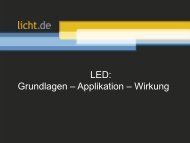licht.wissen No. 01 "Lighting with Artificial Light"
Booklet 1 is intended for all those who want to delve into the topic of light and lighting or wish to familiarize themselves with the basics of lighting technology. It also helps to make a decision in the field of lighting. Free Download at www.licht.de/en
Booklet 1 is intended for all those who want to delve into the topic of light and lighting or wish to familiarize themselves with the basics of lighting technology. It also helps to make a decision in the field of lighting. Free Download at www.licht.de/en
Create successful ePaper yourself
Turn your PDF publications into a flip-book with our unique Google optimized e-Paper software.
<strong>licht</strong>.<strong>wissen</strong> <strong>01</strong><br />
<strong>Lighting</strong> <strong>with</strong> <strong>Artificial</strong> Light<br />
48<br />
Direction of light and modelling<br />
Without light we cannot make out objects; <strong>with</strong>out shadows we see objects merely as two-dimensional images.<br />
Only the right distribution of light and shade ensures that faces and gestures, surfaces and structures can be<br />
accurately discerned.<br />
[48] Directional light and the correct distribution<br />
of light and shade reveal the details of<br />
the figures.<br />
[49 + 50] Distracting shadows should be<br />
avoided if the light comes mainly from<br />
above left (for right-handed people – or from<br />
above right for left-handed people).<br />
[51] In order to avoid stark shadows<br />
in sports halls, the lights are arranged so<br />
that their beams cancel out each other’s<br />
shadows.<br />
A pleasant light climate is created when the<br />
people, architecture and interior furnishings<br />
are illuminated in such a way that shapes<br />
and surface structures are clearly visible:<br />
distances can then be easily estimated, facilitating<br />
orientation <strong>with</strong>in the room.<br />
A mixture of diffuse light (such as indirect<br />
light on walls and ceilings) and directional<br />
light (such as direct luminaires or downlights)<br />
achieves optimum visual results and<br />
contributes to a pleasant visual climate.<br />
Conversely, a bright room <strong>with</strong> nothing but<br />
diffuse lighting and no shadows leaves a<br />
monotonous impression: the lack of orientation<br />
makes us feel uncomfortable. By<br />
contrast, point sources of extremely directional<br />
light create strong shadows <strong>with</strong><br />
stark edges. It is almost impossible to see<br />
anything in these stark shadows. They can<br />
give rise to optical illusions which often<br />
constitute a source of danger, for example<br />
when using tools or machines. The same<br />
applies for unsuitable stair lighting.<br />
Visual communication<br />
A precondition for good visual communication<br />
is for objects and faces to be recognized<br />
quickly and easily. In rooms in which<br />
people move and work, DIN EN 12464-1<br />
therefore stipulates an average cylindrical<br />
illuminance – E Z of at least 50 lux. In areas<br />
where good visual communication is especially<br />
important, such as in reception areas,<br />
shops and schools or in conference rooms,<br />
150 lux are recommended as an average.<br />
DIN EN 12464-1 cites modelling as an important<br />
quality criterion for the 3D perception<br />
of people and objects. It describes the<br />
relationship between cylindrical and horizontal<br />
illuminance at a particular point and<br />
should be between 0.30 and 0.60.<br />
Light direction<br />
Directional light can emphasize visual details.<br />
However, stark and intrusive shadows<br />
(such as those caused by point sources of<br />
light) should be avoided. The light direction<br />
24

















